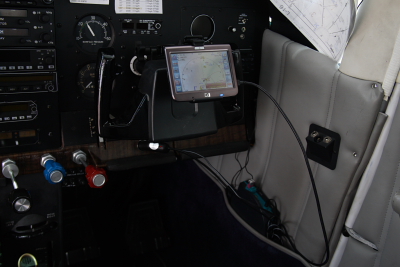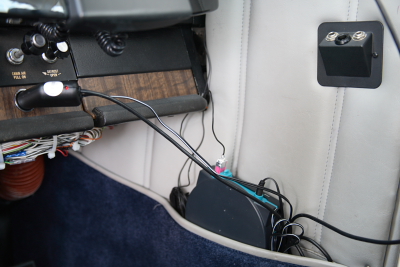Along with a speed enhancement, I would want to make sure that I did not hurt my current STOL performance. Hmmm... Is this possible? Well at leaset with removal of fairings when need be, it might be. Things that cannot be removed have to be carefully considered.
With high gas prices, people have wondered if some improvements would make economic sense to go faster. But most of the improvements only gain you a little bit and cost a fair amount of money. Maybe the time difference is really not much either. But I can dream or try to find the best bang for the buck.
Rigging
If you C182 needs a lot of rudder trim when straight and level, you might want to seriously look into this. Or if one wing tip seems to want to be lower to fly straight. Mine seems pretty good to me, so I think I am ok there.
Wheel FairingsWheel fairings can make a decent difference. Although the stock ones do not do a tremendous amount. From what I hear, the nose wheel fairing makes the biggest difference. There is not much to gain over the stock main gear wheel fairing.
On the nose wheel, the scissors and the exposed nose strut cause a lot of drag. The stock fairing covers the wheel but does not do much for the strut. The cowling does not do much to help either; it does not help split the air flow to the sides of the strut. There are three alternatives that I have interest in.
With all the costs, you have to make sure you include enough for installation and of course painting. I would guess matching colors could be problematic as well.
Horton/Siebel Flight bonus speed mods
 If you do all their modifications, it can add up to somewhere around $6000 of just parts. They agree that the best improvements are for the nose grear. They claim a 7 mph (6knots) improvement. I think the nose gear price is much lower, but I do not have the number. Maybe $2000? Their system changes the scissors and makes them be more streamlined and also not extend as far when off the ground. The stock strut extends a long ways when unloaded. Check it out sometime... They also do modifications to the cowling to help split the air flow around the strut. It looks like a pretty decent system, but the most expensive of the three. I also wonder if the changed scissors are a concern for landing on rough backcountry strips.
If you do all their modifications, it can add up to somewhere around $6000 of just parts. They agree that the best improvements are for the nose grear. They claim a 7 mph (6knots) improvement. I think the nose gear price is much lower, but I do not have the number. Maybe $2000? Their system changes the scissors and makes them be more streamlined and also not extend as far when off the ground. The stock strut extends a long ways when unloaded. Check it out sometime... They also do modifications to the cowling to help split the air flow around the strut. It looks like a pretty decent system, but the most expensive of the three. I also wonder if the changed scissors are a concern for landing on rough backcountry strips.
Here are some links to find out more information on them:
http://stackdoor.com/products.htm
http://members.cox.net/mcadams/siebel182.pdf
http://www.aviationconsumer.com/issues/31_6/avionicsreport/5065-1.html
Knots2U
Another one is made by Knots2U. It has had some good reviews on the Cessna Forums. It retains the standard scissors, but has improved wheel and cowl fairings to improve the air flow around the strut. They two are sold in separate pieces, but I would think you would want both. They claim 4-9mph (3.5-8knots) for all their pieces and and 3-4mph for their cowl piece and indicate that all improvements are not additive. I do not see it separated out for the nose gear fairing.

I found two links regarding these fairings:
http://knots2u.com/Cessna-GF.htm
http://knots2u.com/Cessna%20Cowl.htm
They charge currently $895 for the nose gear fairing and $525 for the Cowl change. The comment on the nose gear fairing being in two pieces which makes it easy to assemble/disassemble.
Fancy Pants
The last is branded Fancy Pants. It is the cheapest and appears to do similar things. From the descriptions, it is all done in the nose gear fairing. But the fairing has a telescopic effect which goes up to the cowling. Actually, this system is an add-on and used in conjunction with the stock fairing. They claim a 5-8 mph (4-7knots) gain.

Nose wheel fairing add-on $275. In their FAQ section, they claim it can be taken on and off in 5 minutes. I have seen some comments to watch out for the tow bar hookups to make sure you get what you want. Something about the size of the tow bar hole sometimes being excessive.
The link for more information on this one is:
http://www.aircraftspeedmods.ca/products.htm
Exhaust Fairings
The same place that sells the Fancy Pants also sells exhaust fairings. In some places, I saw people wondering if it would help speed. But it appears to not do much for speed, but help with the cooling of the engine. This can of course be very good for the life of your engine, but does not help our speed quest.

Flap gap seals
Flap gap seals can be a great way to gain speed and not be too expensive. They do need painting, so make sure you consider this in the plan.
One other thing to consider is that I have heard that it can degrade the STOL characteristics a little. The air flow between the wing and the top of the barn door flaps will be reduced and I hear can increase the stall speed. Another spot claims that flap gap seals will reduce your stall speed, so I am not sure what to think.
Here is a link to one offered by Flight Bonus:
http://stackdoor.com/flightbonus_kit_c182-gap.htm
They claim a 1.5mph increase in speed from flap gap seals.
Engine upgrades
This will get you speed, but not much for gas savings. But as I mentioned gas savings are probably minimal anyways.
One other problem with engine upgrades is that you are trying to speed up a plane that is already draggy. The improvement may come in climb rate, but maybe not as much in cruise speed.
Larger Engine
The two I would consider at an Engine overhaul are:
http://www.pponk.com/ PPonk conversion
http://txskyways.com/products.htm Texas Skyways conversion.
Both are fairly similar and have larger cylinders and more power (34-45 more hp), but not much increase in weight. Another thing to consider is which propeller you can use. If I go with the Pponk, I will have to convert to a 3-bladed prop. I am not sure on the Petersen conversion.
Pponk claims a 13 knot increase in speed at the same MP/RPM settings but higher fuel rates around 6-8k feet. The cost is a little more than an overhaul ($25-30,000?), but where it can add up is needing a 3 bladed prop and spinner which can add another $10,000 or so.
Supercharger
There is a relatively new offering getting good reviews for C182s. It is for a supercharger. There in the past was a turbocharger STC, but it is no longer being made. But the Supercharger seems like it has some interesting benefits. It does not degrade the fuel economy much and does not cause a pressurized exhaust.
http://www.forcedaeromotive.com/
http://www.forcedaeromotive.com/aopaarticle.pdf
They claim a 17 knot increase in IAS before and after at 12k feet. Cost is $19,650 plus installation.
Living next to the Rocky Mountains, this has a fair amount of appeal. I go up to 13k quite frequenly and at times it would be nice to go up to 17k to avoid the turbulence that can happen over the rockies. At those altitudes, the speed goes up quite nicely. It doesn't help at the low altitudes, but I start out at 5k on the ground.
Smarter Flying
Picking the right altitude to fly or altering course north or south for the best winds can go a long ways on a long trip. This may be the best bang for the buck going east. Going west I don't have as many choices due to the altitudes. If I got the supercharger, then more options would probably open up for smart altitudes and directions going west.
Some Cessna Forum links:
If you belong to the Cessna Forums, this topic has been discussed greatly. Here is one link, but it would be recommended to search a fair amount more if you are interested. http://www.cessna.org/forums/showflat.php?Cat=0&Number=549582&page=&fpart=1&vc=1
AOPA
On AOPA, I found a list of STCs for the Cessna 182, it might be a good place to get more information as well.
http://www.aopa.org/pilot/features/skylane0012.html
Measuring Speed Improvements
When checking what different people get with their speed improvements, be careful. People will claim certain MP and RPM settings and speeds and compare against the POH. But many times the RPM and MP can be wrong on the guages. Also, rigging plays a big factor. The best thing is probably to try to get before and after speeds from somebody.
Summary
If you really want speed, a different plane is probably the best way. My problem is that I want to go slow too. Own two airplanes then? Well maybe if I win the lottery.
Otherwise, I will stick with what I have and do small things (maybe the fancy pants nose wheel fairing) or things when I need an engine overhaul such as a PPonk or the Supercharger.
/Brian



